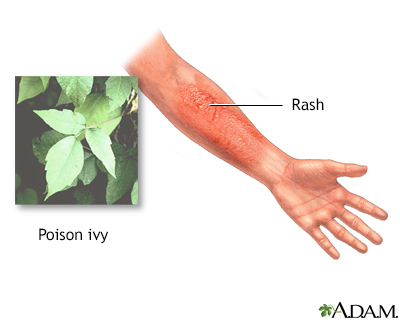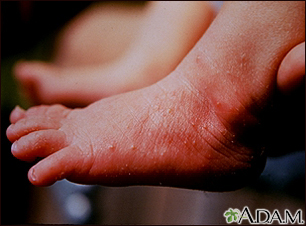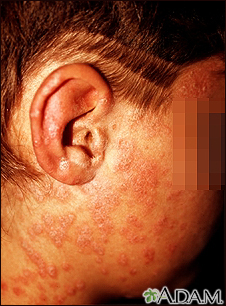Pregnancy SmartSiteTM
Skin redness or inflammation; Skin lesion; Rubor; Skin rash; Erythema DefinitionRashes involve changes in the color, feeling or texture of your skin. ConsiderationsOften, the cause of a rash can be determined from how it looks and its location and symptoms. Skin testing, such as a scraping or biopsy, may also be used to help with diagnosis. Sometimes, the cause of the rash remains unknown. CausesA simple rash is called dermatitis, meaning inflammation of the skin. Contact dermatitis is caused by things your skin touches, such as:
 Seborrheic dermatitis is a rash that appears in patches of redness and scaling around the eyebrows, eyelids, mouth, nose, trunk, and behind the ears. If it happens on your scalp, it is called dandruff in adults and cradle cap in infants. Age, stress, fatigue, weather extremes, oily skin, infrequent shampooing, and alcohol-based lotions aggravate this harmless but bothersome condition. Other common causes of a rash include:
Many medical conditions can cause a rash as well. These include:
Home CareMany simple rashes will improve with gentle skin care and by avoiding irritating substances. Follow these general guidelines:
Hydrocortisone cream (1%) is available without a prescription and may soothe many rashes. Stronger hydrocortisone or other steroid creams are available with a prescription. If you have eczema, apply moisturizers over your skin. Try oatmeal bath products, available at drugstores, to relieve symptoms of eczema or psoriasis. Oral antihistamines may help relieve itchy skin. When to Contact a Medical ProfessionalCall 911 or the local emergency number if:
Contact your health care provider if:
What to Expect at Your Office VisitYour provider will perform a physical examination and ask about your medical history and symptoms. Questions may include:
Tests may include:
Depending on the cause of your rash, treatments may include medicated creams or lotions, medicines taken by mouth, or skin surgery. Many primary care providers are comfortable dealing with common rashes. For more complicated skin disorders, you may need a referral to a dermatologist. ReferencesJames WD, Elston DM, Treat JR, Rosenbach MA, Neuhaus IM. Cutaneous signs and diagnosis. In: James WD, Elston DM, Treat JR, Rosenbach MA, Neuhaus IM, eds. Andrews' Diseases of the Skin. 13th ed. Philadelphia, PA: Elsevier; 2020:chap 2. Ko CJ. Approach to skin diseases. In: Goldman L, Schafer AI, eds. Goldman-Cecil Medicine. 26th ed. Philadelphia, PA: Elsevier; 2020:chap 407. | |
| |
Review Date: 11/30/2022 Reviewed By: Ramin Fathi, MD, FAAD, Director, Phoenix Surgical Dermatology Group, Phoenix, AZ. Also reviewed by David C. Dugdale, MD, Medical Director, Brenda Conaway, Editorial Director, and the A.D.A.M. Editorial team. The information provided herein should not be used during any medical emergency or for the diagnosis or treatment of any medical condition. A licensed medical professional should be consulted for diagnosis and treatment of any and all medical conditions. Links to other sites are provided for information only -- they do not constitute endorsements of those other sites. No warranty of any kind, either expressed or implied, is made as to the accuracy, reliability, timeliness, or correctness of any translations made by a third-party service of the information provided herein into any other language. © 1997- A.D.A.M., a business unit of Ebix, Inc. Any duplication or distribution of the information contained herein is strictly prohibited. | |

 Rash
Rash Poison oak rash on...
Poison oak rash on... Erythema toxicum o...
Erythema toxicum o... Acrodermatitis
Acrodermatitis Roseola
Roseola Shingles
Shingles Cellulitis
Cellulitis Erythema annulare ...
Erythema annulare ... Psoriasis - guttat...
Psoriasis - guttat... Psoriasis - guttat...
Psoriasis - guttat... Systemic lupus ery...
Systemic lupus ery... Poison ivy on the ...
Poison ivy on the ... Poison ivy on the ...
Poison ivy on the ... Erythema multiform...
Erythema multiform... Erythema multiform...
Erythema multiform... Erythema multiform...
Erythema multiform...
